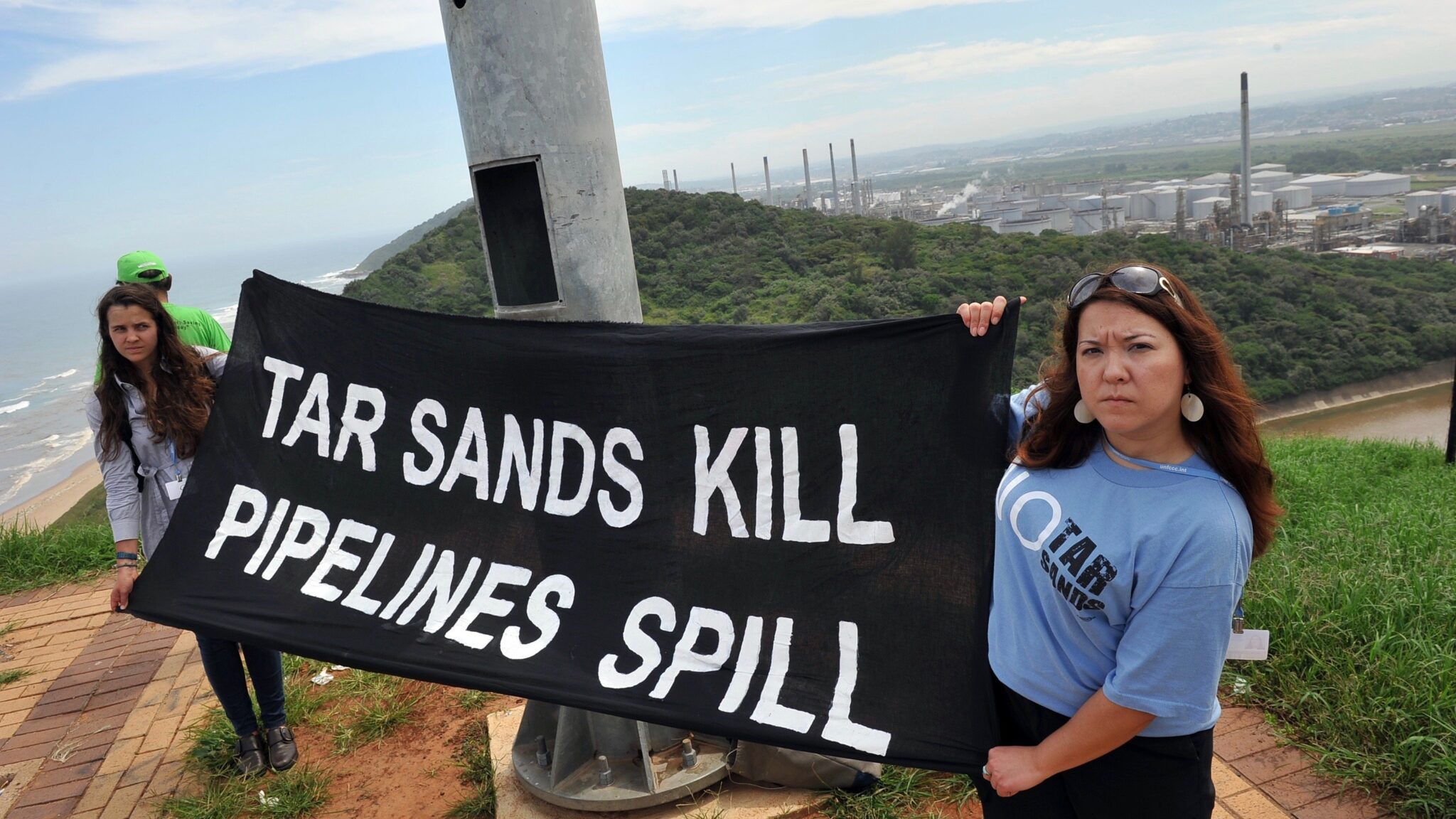
World’s Banks Have Given $2.7 Trillion to Fossil Fuels Since Paris Agreement Begun, Study Shows

The Canadian banks are the biggest bankers of tar sands and they all lack policies restricting their financing to this subsector. A new report reveals that the business practices of the world's major private-sector banks continue to drive us toward climate disaster. ALEXANDER JOE / AFP / Getty Images
Financial companies are increasingly being recognized — by their clients, shareholders, regulators, and the general public — as climate actors, with a responsibility to mitigate their climate impact. For the banks highlighted in this report, the last year has brought a groundswell of activism demanding banks cut their fossil fuel financing, at the same time that increasingly extreme weather events have further underscored the urgency of the climate crisis. Nevertheless, the report reveals that the business practices of the world’s major private-sector banks continue to drive us toward climate disaster.
Adding up lending and underwriting from 35 private-sector banks to the fossil fuel industry, this report finds that Canadian, Chinese, European, Japanese, and U.S. banks have financed fossil fuels with $2.7 trillion since the Paris agreement was adopted (2016-2019), with financing on the rise each year. The report finds that fossil fuel financing continues to be dominated by the big U.S. banks — JPMorgan Chase, Wells Fargo, Citi, and Bank of America — together, these four banks account for a staggering 30 percent of all fossil fuel financing from the 35 major global banks since the Paris agreement was adopted.
Also examined are the banks’ support for 100 top fossil fuel companies that are expanding fossil fuels, given that there is no room for new fossil fuels in the world’s carbon budget. Banks continued to support these companies with 5 billion in the last four years. Despite the urgent need to immediately halt all fossil fuel expansion, financing for these top 100 expanders skyrocketed 40 percent from 2018 to 2019.
The report card also assesses bank policy and practice around financing in certain key fossil fuel subsectors, with league tables and policy grades on:
- Tar Sands Oil: The biggest bankers of tar sands — the Canadian banks, led by TD and RBC, plus JPMorgan Chase and Barclays — all lack policies restricting their financing to this subsector.
- Arctic Oil and Gas: 2019 saw a slew of bank policies restricting financing primarily for project financing in the Arctic. But overall, bank financing to top Arctic oil and gas companies has gone up every year since Paris
- Offshore Oil and Gas: This year’s report looks not just at ultra-deepwater oil and gas, but rather all offshore oil and gas, where the biggest bankers since Paris are JPMorgan Chase, Citi, and BNP Paribas.
- Fracked Oil and Gas: Fracking financing is dominated by the U.S. banks: JPMorgan Chase, Wells Fargo, Bank of America, and Citi. Only a handful of banks, all European, have begun to place significant restrictions on financing for fracked oil and gas.
- Liquefied Natural Gas (LNG)?: Morgan Stanley and JPMorgan Chase are the world’s biggest bankers since Paris of top companies building LNG import and export terminals, but Mizuho was biggest in 2019.
- Coal Mining: China Construction Bank and Bank of China are the biggest bankers of coal mining, while French banks Credit Mutuel and Credit Agricole have the strongest policy scores.
- Coal Power: This is the area where bank policy scores are strongest overall; yet funding for top coal power producers is not dropping rapidly enough. Financing is led by ICBC and Bank of China, with Citi as the top non-Chinese banker of coal power.
In this new decade, the climate emergency is clearer than ever, with emissions cuts of almost 5 percent necessary by 2030 if we are to have a coin-flip chance of limiting global warming to 1.5°C. To align their policies and practices with a world that limits global warming to 1.5°C and fully respects human rights, and Indigenous rights in particular, banks must:
- Explicitly acknowledge the central role of the fossil fuel industry as the major driver of climate breakdown, as well as the banks’ own role in financing this sector.
- Prohibit all financing for all fossil fuel expansion projects and companies expanding fossil fuel extraction and infrastructure (such as plants and pipelines).
- Commit to phase out all financing for fossil fuel extraction and infrastructure, on an explicit timeline that is aligned with limiting global warming to 1.5°C.
- Phase out financing for existing projects and companies active in tar sands oil, Arctic oil and gas, offshore oil and gas, fracked oil and gas, liquefied natural gas, coal mining, and coal power, with ending financing for expansion of these subsectors as an urgent first step.
- Fully respect all human rights, particularly the rights of Indigenous peoples, including their rights to their water and lands and the right to free, prior, and informed consent, as articulated in the UN Declaration on the Rights of Indigenous Peoples.156 Prohibit all financing for projects and companies that abuse human rights, including Indigenous rights.
- The City of Angels Funds Some Hellish Fossil Fuel Projects ...
- European Investment Bank Will Stop Funding Fossil Fuel Projects by ...
- Global Banks, Led by JPMorgan Chase, Invested $1.9 Trillion in ...
- Report Shows Banks Loaned $2.6 Trillion Linked to Biodiversity Loss - EcoWatch
- Bank Lending to Fossil Fuel Companies Increased After Paris Agreement

 233k
233k  41k
41k  Subscribe
Subscribe 